You'll find seven reliable static dissipative foam thicknesses for protecting your electronic components. The options range from low-profile 1/8-inch sheets for delicate parts to robust 100mm double-layer systems for maximum protection. The most popular choices include quarter-inch foam for standard components, half-inch for balanced protection, three-quarter-inch for high-value items, one-inch for fragile electronics, and custom-cut 50mm for larger equipment. Each thickness offers specific benefits regarding ESD protection, shock absorption, and cost-effectiveness. Let's explore which thickness will work best for your unique electronics protection needs.
Low-Profile 1/8-Inch Foam Sheets
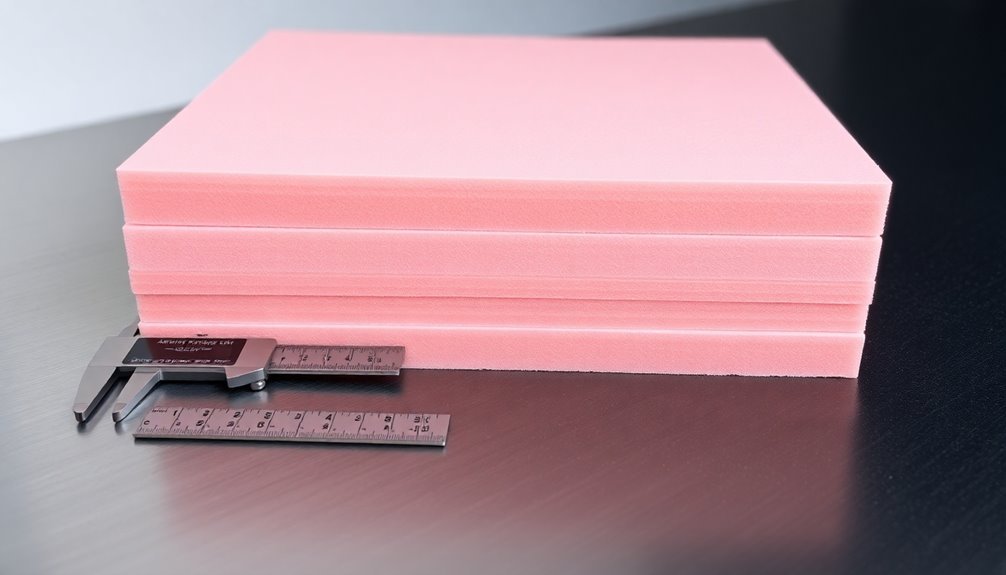
Three key features make 1/8-inch static dissipative foam sheets an ideal choice for protecting delicate electronics. First, their thin profile allows for optimal space utilization when packaging miniature devices and small circuit boards.
Second, they provide effective ESD protection while maintaining permanent static dissipative properties.
Third, they offer just enough cushioning for components that need minimal shock absorption in tight spacing applications.
You'll find these low-profile foam sheets available in both polyethylene and polyurethane materials. If you're working with components that need a clean, non-corrosive environment, choose polyethylene with its closed-cell structure. Their density of 45-67kg/m³ ensures reliable protection while maintaining flexibility. The surface resistance of 10^3-10^5 provides optimal static dissipation for sensitive electronics.
For applications requiring additional cushioning, polyurethane's open-cell structure delivers enhanced protection while maintaining conductivity.
When you're handling sensitive electronic components, these 1/8-inch sheets deliver reliable performance without taking up excessive space. You can customize them to fit specific component sizes and shapes, making them versatile for various electronic packaging needs.
While they don't provide extensive shock absorption due to their thin profile, they're perfect for densely packed electronic components where space is at a premium and minimal cushioning is required.
Quarter-Inch Standard Protection Layer
You'll find quarter-inch static dissipative foam offers an ideal balance of protection and cost-effectiveness for most standard electronic components ranging from 1-4 inches in size.
The 1/4-inch thickness proves especially suitable for circuit boards, microprocessors, and memory modules, providing sufficient cushioning without excess material waste. The material's closed cell structure ensures chemical and physical stability for long-term storage. With a surface resistance range of 10^6-10^9 Ω, it delivers reliable electrostatic protection for sensitive electronics.
While this thickness costs more per square foot than 1/8-inch options, its superior protection and durability make it the industry standard for protecting mid-sized electronic components during storage and transport.
Common Applications Quarter-Inch
Quarter-inch static dissipative foam stands out as the industry standard for protecting general electronics during shipping and storage. You'll find this 6.4mm thickness commonly used in packaging sensitive circuit boards and electronic components, offering an ideal balance of protection and cost-effectiveness.
The foam's surface resistance varies depending on its type, with conductive foams measuring between 10^3-10^5 ohms, while dissipative variants feature higher resistance levels. For optimal protection, maintaining a static decay rate of 5 KV-O volts in 2 seconds is recommended.
When you're selecting quarter-inch foam for your electronics, you'll need to take into account several key factors. The material should meet ESD certification requirements and maintain its protective properties under varying environmental conditions. Most manufacturers offer maximum thicknesses up to 30mm for specialized applications requiring enhanced protection.
You can choose from polyurethane or polyethylene foams, typically available in standard sheet sizes like 24" x 36". These materials undergo rigorous quality control testing to confirm they meet industry standards.
You'll want to verify that your chosen foam's cushioning properties match your specific needs. Reflect on factors like the material's density, tensile strength, and compatibility with your electronic components.
Remember that humidity and temperature can affect the antistatic properties, particularly in pink antistatic foams, so proper storage conditions are essential for maintaining effectiveness.
Cost-Benefit Analysis
Several compelling factors make quarter-inch static dissipative foam the most economical choice for protecting electronic components. You'll find it strikes an ideal balance between protection and cost-effectiveness, especially when you're handling general-purpose electronic items and circuit boards. The quarter-inch thickness provides sufficient cushioning against physical damage while meeting essential ESD protection standards. Static dissipative foam provides optimal protection with its resistance of 10^5-10^9 ohms. Its blue coloring makes it easily identifiable in manufacturing environments.
When you're considering costs, you'll notice quarter-inch foam offers significant advantages over thicker alternatives. It's less expensive than thicker options while still delivering adequate protection for most electronic components. You can reduce costs further through bulk purchasing, though custom cutting will add to your expenses.
If you're dealing with highly sensitive components, you might need to weigh the benefits of thicker foams against their higher costs.
You'll find quarter-inch foam particularly cost-effective when used in ESD containers and anti-static packaging. While thinner foams might save money initially, they often don't provide adequate protection. Conversely, thicker foams can be unnecessarily expensive for components that don't require extensive cushioning.
For most applications, quarter-inch foam delivers the best return on investment while maintaining proper protection standards.
Ideal Component Size Range
Building on the cost-effectiveness of quarter-inch foam, understanding its preferable size range for components helps maximize your protection investment. The quarter-inch thickness proves most suitable for small to medium-sized electronic components, particularly those measuring between 6mm to 305mm in length or width. Anti-static foam offers smooth surface options for optimal component contact.
You'll find that quarter-inch static dissipative foam effectively protects components like integrated circuits, memory modules, and smaller circuit boards. The standard sheet sizes, ranging from 6mm by 305mm to larger variants like the 16-5/8 by 12-5/8 inches dimensions, allow you to protect these components while maintaining excellent cost efficiency.
When you're working with polyurethane or polyethylene foams at this thickness, you'll achieve sufficient cushioning for components weighing up to moderate weights. For your smaller components, such as resistors and capacitors, quarter-inch foam provides more than adequate protection without excess material waste.
If you're handling components around 6mm to 228mm in size, the quarter-inch thickness offers preferable surface contact and static dissipation properties. The foam's surface resistance of 10^3-10^5 ohms ensures proper ESD protection while maintaining direct contact with your components, making it particularly effective for this size range.
Half-Inch Cushioning Thickness
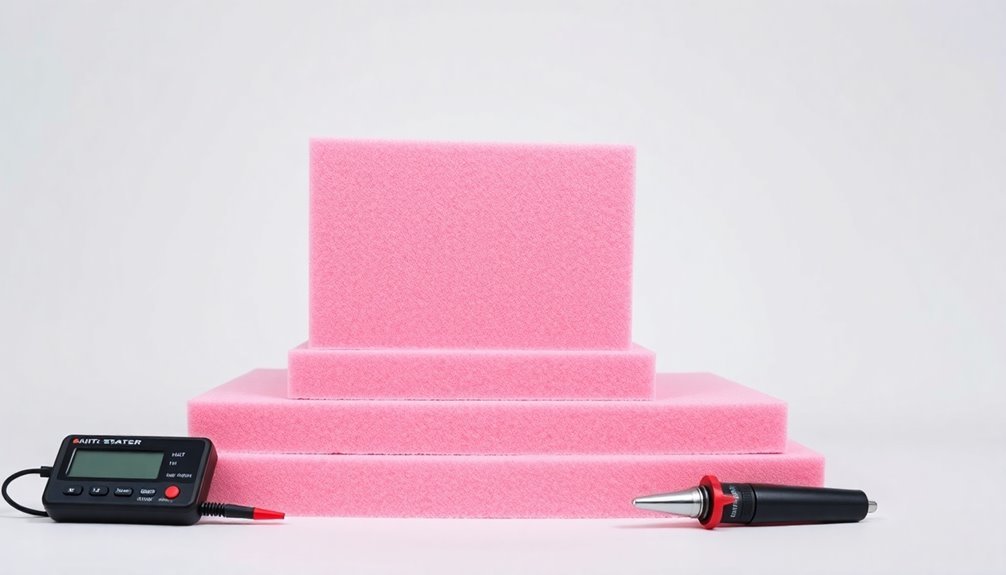
The half-inch thickness represents a popular choice for static dissipative foam applications in electronics packaging. You'll find this thickness readily available in full, half, and third sheet sizes, with prices ranging from $7.99 to $14.99 depending on the dimensions you need.
This thickness provides superior cushioning for most electronic components while maintaining effective static dissipation properties.
When you're working with half-inch static dissipative foam, you'll benefit from its surface and volume resistance ratings of 10e5-10e11 ohms, guaranteeing reliable ESD protection. The closed-cell structure offers enhanced protection against shocks and vibrations during shipping and handling.
You can expect charge decay times of less than 0.05 seconds, meaning static dissipation happens quickly and effectively.
You can easily customize half-inch foam to fit your specific needs, as it's compatible with cutting and shaping for custom applications. The material's thermal stability of less than 2% guarantees your components remain properly protected across various environmental conditions.
For most electronics packaging applications, you'll find that half-inch thickness strikes an ideal balance between protection and practicality while meeting RoHS and Reach compliance standards.
Three-Quarter-Inch Heavy-Duty Protection
Static dissipative foam at three-quarter-inch thickness delivers maximum protection for your most sensitive electronic components.
You'll find this heavy-duty option particularly effective for high-value electronics that require superior cushioning against impacts and vibrations during shipping and storage. The 3/4-inch thickness combines robust physical protection with advanced ESD safeguards through its conductive pathways and dissipative additives.
- Available in both pink antistatic and black conductive variations with density options from 2 to 6 lbs. pcf
- Features specialized eggcrate patterns for enhanced cushioning and professional presentation
- Incorporates low-shedding properties and cleanroom compatibility for sensitive environments
When you're working with static-sensitive components, you'll appreciate how this thickness creates reliable grounding surfaces in workstations while preventing static buildup.
The foam's customizable nature lets you adapt it to specific component shapes, ensuring complete protection. You can use it in various ESD containers, from cardboard boxes to polypropylene cases, where its high-quality polyurethane or polyethylene construction maintains consistent performance.
For electronics requiring thorough protection against both physical damage and static discharge, the three-quarter-inch thickness provides an ideal solution.
One-Inch Maximum Security Thickness
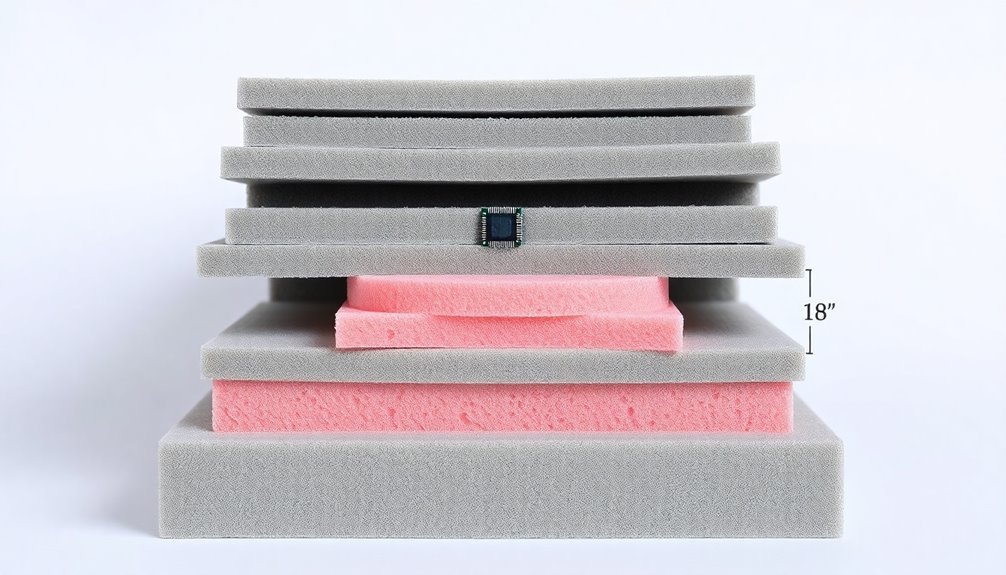
At one inch thick, your static dissipative foam offers the maximum protection range for sensitive electronic components, absorbing severe impacts and vibrations during transit.
You'll find this thickness provides unmatched cushioning for the most valuable or fragile electronics, with exceptional shock absorption capabilities across the entire protective surface.
The rigid support structure of one-inch foam guarantees your components remain securely positioned throughout shipping, eliminating shifting and potential damage from movement.
Maximum Component Protection Range
Protection standards for electronic components have established one inch (25.4mm) as the ideal maximum thickness for static dissipative foam security. This thickness provides excellent protection while maintaining efficiency in packaging and shipping.
You'll find that different foam materials offer varying levels of protection within this range, with ESD PE foam often requiring lamination to reach the desired thickness, while ESD EVA foam can achieve up to 70mm in a single layer.
When selecting foam thickness within the one-inch maximum range, consider these critical factors:
- Component size and sensitivity – larger or more delicate items may require the full inch thickness, while smaller components might need less.
- Shipping distance and conditions – longer transit times or harsh environments warrant utilizing the maximum thickness for added protection.
- Material density requirements – higher density foams like conductive polyethylene offer superior protection even at lower thicknesses.
The one-inch maximum provides sufficient cushioning for most electronic components while allowing for efficient material usage and cost-effective shipping.
For specialized needs, you can customize the thickness within this range using different foam types, including PE, EVA, EPE, or PU, depending on your specific protection requirements.
Rigid Support For Transit
Building upon the one-inch maximum thickness standard, rigid support requirements demand careful evaluation of foam density and material composition for secure transit protection. You'll find that different materials offer varying levels of protection, with polyurethane (PU), polyethylene (PE), and ethylene-vinyl acetate (EVA) being the primary options for electronics packaging.
For ideal transit protection, you'll want to assess these density-to-application ratios:
| Foam Type | Density (kg/m³) | Best Application |
|---|---|---|
| PE Foam | 45 | Light Components |
| EVA Foam | 85 | Medium Components |
| PU Foam | 65 | Sensitive Electronics |
| Memory Foam | 90 | Heavy Components |
| Conductive | 75 | Static-Sensitive Parts |
When selecting rigid support materials, you'll need to match the foam's surface resistance to your components' sensitivity. Conductive foams (10³-10⁵ ohms/sq) work best for highly sensitive electronics, while anti-static varieties (10⁶-10¹¹ ohms/sq) suit general electronic components. The closed-cell structure of ESD PE foam provides excellent rigidity, while ESD EVA foam's customizable thickness up to 70mm offers flexibility for various component sizes.
Custom-Cut 50mm Static Control
Several manufacturers offer custom-cut 50mm static control foam solutions that combine ideal thickness with precise dimensional requirements.
You'll find this thickness particularly effective for protecting larger electronic components that need substantial cushioning during transit. The 50mm thickness provides optimal protection while maintaining the necessary static dissipative properties your sensitive electronics require.
When you're evaluating 50mm custom-cut static control foam, keep these key benefits in mind:
- Maximum shock absorption for heavier electronic components while maintaining effective static control
- Ideal thickness for creating deep compartments in custom insert applications
- Perfect balance between protection and space efficiency in shipping containers
Your choice of material at this thickness will impact long-term performance. EVA foam offers permanent anti-static properties and maintains its protective qualities even at 50mm, making it ideal for long-term storage solutions.
If you're handling semiconductor equipment or larger circuit boards, you'll want to take into account that 50mm static control foam provides enough depth to create secure cavities while ensuring complete static protection.
The thickness also allows for precise custom cutting, enabling you to create exact fits for your specific electronic components.
Double-Layer 100mm Protection Systems
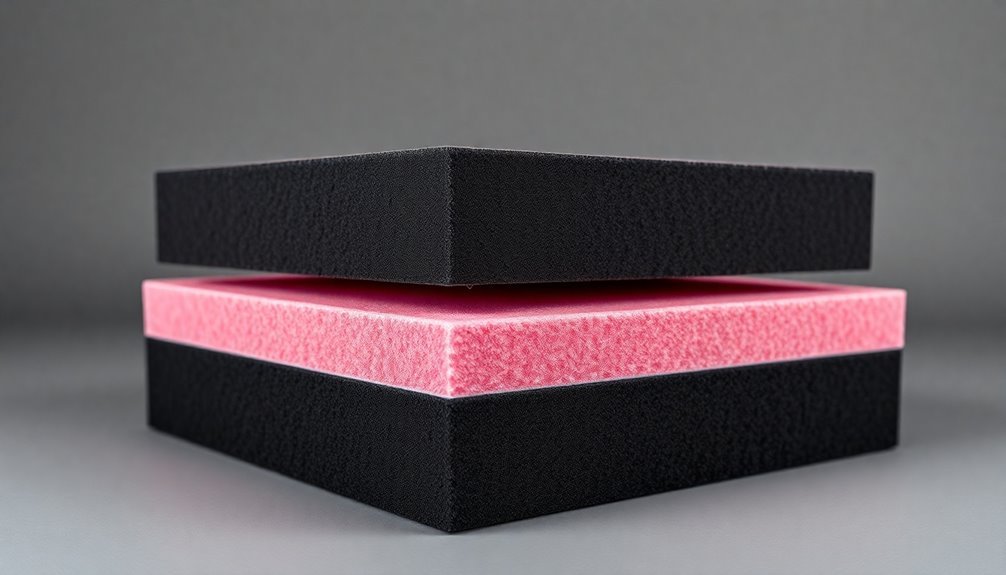
Designed for maximum protection, double-layer 100mm static dissipative foam systems provide exceptional safeguarding for your most sensitive electronic components.
You'll find these systems particularly effective for long-term storage and shipping, thanks to their permanent ESD properties and surface resistance ranging from 10^3 to 10^6 ohms/square.
When you're handling delicate electronics like computer chips and circuit boards, you'll benefit from the system's superior cushioning and shock absorption capabilities.
The foam, typically made from polyethylene or EVA materials, comes in thicknesses from 0.5mm to 100mm and densities between 40kg/m3 to 125kg/m3.
You can choose from various colors, with black being the most common option.
You'll appreciate the versatility of these protection systems, as they're available in custom sizes and multiple foam types.
Whether you're working in cleanrooms or ESD workspaces, you can rely on their non-abrasive, anti-moisture properties.
The double-layer design guarantees your components stay secure, while the environmentally friendly materials are 100% recyclable and free from CFCs and HCFCs.
For your specialized needs, suppliers can create custom solutions to match your exact specifications.
Frequently Asked Questions
Can Static Dissipative Foam Be Safely Reused for Different Electronic Components?
You can reuse static dissipative foam, but you'll need to verify its ESD properties before each use. It's best to test the foam and inspect for damage to guarantee safe protection of components.
How Long Does the Static Dissipative Property Remain Effective in Foam Materials?
You'll find that conductive and static dissipative foams offer permanent protection, while pink antistatic foam's effectiveness depends on humidity. EPE foam lasts about 6 months, and polyethylene/polyurethane foams maintain permanent ESD properties.
What Temperature Ranges Can Static Dissipative Foam Safely Withstand During Storage?
You'll find most static dissipative foams can safely withstand temperatures from -10°C to 85°C during storage. It's best to keep them at room temperature to maintain their protective properties and physical integrity.
Does Cutting Static Dissipative Foam Affect Its Protective Properties Around Cut Edges?
No, you won't lose static protection when cutting the foam. The dissipative properties remain intact along cut edges since they're inherent to the material itself, provided you avoid contamination during the cutting process.
How Should Static Dissipative Foam Be Cleaned Without Compromising Its Effectiveness?
You'll need to clean your static dissipative foam gently using distilled water or mild detergent solution. Don't use harsh chemicals or scrub vigorously. Wipe with a soft, lint-free cloth and dry thoroughly.
In Summary
You'll find these seven foam thickness options provide reliable static protection for all your electronic storage and shipping needs. Whether you're using thin 1/8-inch sheets for basic coverage or implementing robust 100mm double-layer systems, selecting the right thickness is essential. Consider your specific requirements, handling conditions, and component sensitivity when choosing the ideal static dissipative foam for your electronics.

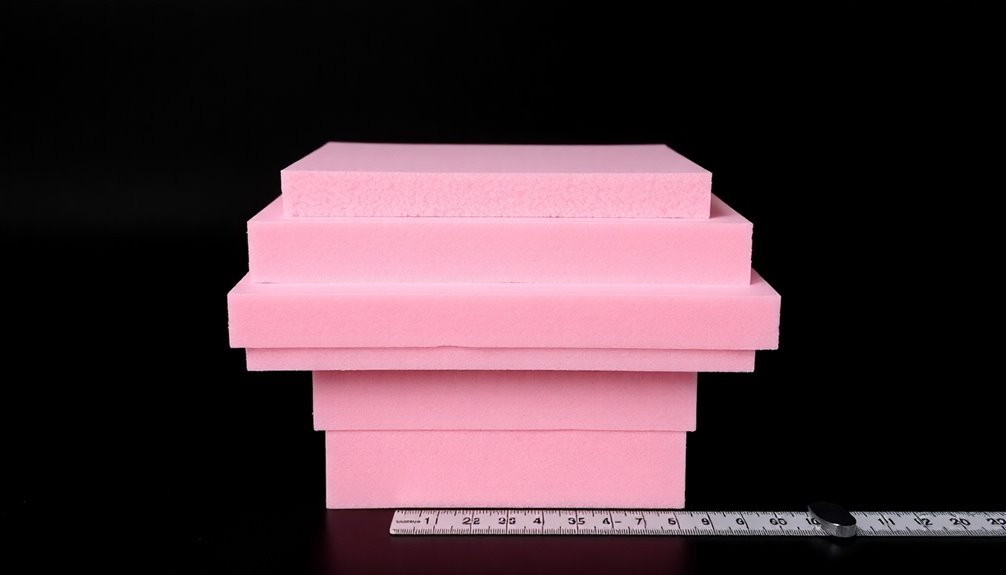



Leave a Reply